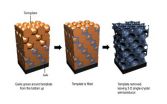(Press-News.org) CHAMPAIGN, Ill. — Glucose meters aren't just for diabetics anymore. Thanks to University of Illinois chemists, they can be used as simple, portable, inexpensive meters for a number of target molecules in blood, serum, water or food.
Chemistry professor Yi Lu and postdoctoral researcher Yu Xiang published their findings in the journal Nature Chemistry.
"The advantages of our method are high portability, low cost, wide availability and quantitative detection of a broad range of targets in medical diagnostics and environmental monitoring," Lu said. "Anyone could use it for a wide range of detections at home and in the field for targets they may care about, such as vital metabolites for a healthy living, contaminants in their drinking water or food, or potential disease markers."
A glucose meter is one of the few widely available devices that can quantitatively detect target molecules in a solution, a necessity for diagnosis and detection, but only responds to one chemical: glucose. To use them to detect another target, the researchers coupled them with a class of molecular sensors called functional DNA sensors.
Functional DNA sensors use short segments of DNA that bind to specific targets. A number of functional DNAs and RNAs are available to recognize a wide variety of targets.
They have been used in the laboratory in conjunction with complex and more expensive equipment, but Lu and Xiang saw the potential for partnering them with pocket glucose meters.
The DNA segments, immobilized on magnetic particles, are bound to the enzyme invertase, which can catalyze conversion of sucrose (table sugar) to glucose. The user adds a sample of blood, serum or water to the functional DNA sensor to test for drugs, disease markers, contaminants or other molecules. When the target molecule binds to the DNA, invertase is released into the solution. After removing the magnetic particle by a magnet, the glucose level of the sample rises in proportion to the amount of invertase released, so the user then can employ a glucose meter to quantify the target molecule in the original sample.
"Our method significantly expands the range of targets the glucose monitor can detect," said Lu, who also is affiliated with the Beckman Institute for Advanced Science and Technology and with the Frederick Seitz Materials Research Lab at U. of I. "It is simple enough for someone to use at home, without the high costs and long waiting period of going to the clinics or sending samples to professional labs."
The researchers demonstrated using functional DNA with glucose meters to detect cocaine, the disease marker interferon, adenosine and uranium. The two-step method could be used to detect any kind of molecule that a functional DNA or RNA can bind.
Next, the researchers plan to further simplify their method, which now requires users to first apply the sample to the functional DNA sensor and then to the glucose meter.
"We are working on integrating the procedures into one step to make it even simpler," Lu said. "Our technology is new and, given time, it will be developed into an even more user-friendly format."
INFORMATION:
The U.S. Department of Energy, the National Institutes of Health and the National Science Foundation supported this work.
Editor's notes:To reach Yi Lu, call 217-333-2619; email yi-lu@illinois.edu.
The paper, Using Personal Glucose Meters and Functional DNA Sensors to Quantify a Variety of Analytical Targets, is available from the U. of I. News Bureau.
Pocket chemistry: DNA helps glucose meters measure more than sugar
2011-07-25
ELSE PRESS RELEASES FROM THIS DATE:
New photonic crystals have both electronic and optical properties
2011-07-25
CHAMPAIGN, Ill. — In an advance that could open new avenues for solar cells, lasers, metamaterials and more, researchers at the University of Illinois have demonstrated the first optoelectronically active 3-D photonic crystal.
"We've discovered a way to change the three-dimensional structure of a well-established semiconductor material to enable new optical properties while maintaining its very attractive electrical properties," said Paul Braun, a professor of materials science and engineering and of chemistry who led the research effort.
The team published its advance ...
Epigenetic 'memory' key to nature versus nurture
2011-07-25
Researchers funded by the Biotechnology and Biological Sciences Research Council (BBSRC) at the John Innes Centre have made a discovery, reported this evening (24 July) in Nature, that explains how an organism can create a biological memory of some variable condition, such as quality of nutrition or temperature. The discovery explains the mechanism of this memory – a sort of biological switch – and how it can also be inherited by offspring.
The work was led by Professor Martin Howard and Professor Caroline Dean at the John Innes Centre, which receives strategic funding ...
Soft spheres settle in somewhat surprising structure
2011-07-25
Latex paints and drug suspensions such as insulin or amoxicillin that do not need to be shaken or stirred may be possible thanks to a new understanding of how particles separate in liquids, according to Penn State chemical engineers, who have developed a method for predicting the way colloidal components separate based on energy.
"The ongoing assumption was that if you have a mixture of different sized particles in a liquid, the faster-settling particles will end up on the bottom," said Darrell Velegol, professor of chemical engineering. "We found that in many cases it ...
Mismatch between cancer genetics counseling and testing guidelines and physician practices
2011-07-25
A new analysis has found that many doctors report that they do not appropriately offer breast and ovarian cancer counseling and testing services to their female patients. Published early online in CANCER, a peer-reviewed journal of the American Cancer Society, the study indicates that efforts are needed to encourage these services for high-risk women and discourage them for average-risk women.
Women with mutations in the BRCA1 or BRCA2 gene have a substantially increased risk of developing breast and ovarian cancer, but there are medical treatments that can dramatically ...
Children eating more, and more frequently outside the home
2011-07-25
Philadelphia, PA, July 25, 2011 – As childhood obesity rises and the American diet shifts towards increasing consumption of foods eaten or prepared outside of the home, concerns about the nutritional quality and the total consumption of such foods are also increasing. According to a study conducted at the University of North Carolina at Chapel Hill and published in the August 2011 issue of the Journal of the American Dietetic Association, eating location and food source significantly impact daily energy intake for children. Foods prepared away from home, including fast ...
Catching the West Nile virus in action
2011-07-25
Tel Aviv — Since 1999, several outbreaks of West Nile Virus, which causes fever or severe neurological symptoms and is transmitted from birds to humans by blood-sucking mosquitoes, have been seen in the U.S., usually during the summer months. But researchers aren't certain how the virus migrated here — and they don't know how, or where, it will appear next.
Now Prof. Ella Mendelson of Tel Aviv University's School of Public Health at the Sackler Faculty of Medicine, working with the Israeli Ministries of Health and Environment, has instituted a study that tracks both clinical ...
Double jeopardy: Tuna and billfish
2011-07-25
MIAMI – July 25, 2011 – A new study by top global fisheries experts presents an alarming assessment of several economically important fish populations. The analysis of 61 species of "scombrids," which include tunas, bonitos, mackerels and Spanish mackerels, and billfishes, which include swordfish and marlins, classified seven as threatened with extinction and four as "near threatened" for the IUCN Red List of Threatened Species.
University of Miami Rosenstiel School of Marine & Atmospheric Science associate professor, and assistant director of NOAA's Cooperative Institute ...
Pekasus, Factory of Animated Dreams, Today Announces the Publication of its Newest Book in its Ongoing Series, Spark the Stone Man
2011-07-25
The book's 16 full-color illustrations are the handiwork of British Academy Award recipient and Oscar nominee, Olga Titova. Another key participant in the project is Aida Zyablikova, a movie director and a British Academy Award recipient and Oscar nominee.
Asya Pekurovskaya says there will eventually be six books in the Spark's series. Two have now been published and two more are waiting in the wings. She is currently at work finishing the final two. Each book, she says, stands on its own but also builds upon earlier books and the Spark the Stone Man cosmology. The entire ...
Win Top Technology Prizes with Cake Poker and RakeTheRake
2011-07-25
In celebration of its recent relaunch, RakeTheRake has three superb technology prizes to be won, courtesy of Cake Poker. The promotion is part of a three month period of special relaunch promotions , running until 31 July. Worth $100k+, these promotions are on top of the regular $500k+ of monthly promotions at RakeTheRake.com.
Cake Poker players can play to win one of these great prizes: 1st place will win an X-box and a large screen TV; 2nd place will win a new iPad2 and 3rd place will receive a notebook.
Cake Poker players can enter by checking the rake requirements ...
Triad Alcohol Pads Recalled After Reports of Deadly Bacteria Contamination
2011-07-25
Despite the recall of millions of alcohol wipes, swabs and swabsticks by manufacturer Triad Group, new reports of serious infections and deaths continue. According to the Food and Drug Administration, these alcohol prep pads are used to disinfect the skin prior to an injection, but tests have shown that a large number of the pads are infected with a lethal bacteria Bacillus cereus.
The pads were sold at Walgreens, CVS and countless other drug stores throughout the country. Prior to the recall of the potentially dangerous drug, the pads were also used at hospitals across ...




